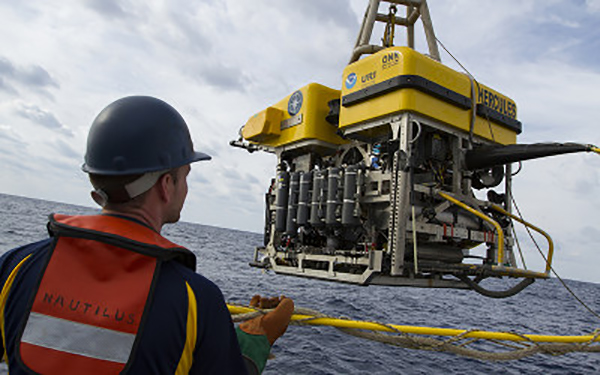Studying Biodiversity and Pharmaceutical Potential on the Seafloor

Three scientists at Scripps Institution of Oceanography at UC San Diego will lead a cruise off Southern California beginning Oct. 27 to explore the biodiversity of deep sea habitats that are rich in minerals like phosphorus and manganese. Their goal is to document the life forms inhabiting these unique environments and assess their potential to yield chemical substances with pharmaceutical potential.
The public will be able to see what the scientists see in real time when the researchers guide a remotely operated vehicle as it explores the ocean floor, collecting specimens of marine life and samples of mineral-rich rock and sediment.
“Surprisingly, there are still areas off Southern California where marine life remains unexplored,” said lead scientist and Scripps biological oceanographer Lisa Levin. “We think it is important to understand the biodiversity of seafloor life associated with these different minerals that are increasingly targeted for mining by society, prior to decisions about exploitation.”
“This includes the microbes that inhabit these sites,” which represent an important component of the ecosystem and a potential source of new pharmaceuticals, added Jensen.

Scripps scientists will guide ROV Hercules from E/V Nautilus. Photo: Ocean Exploration Trust
Scripps’ Levin, marine biologists Paul Jensen and Greg Rouse, and U.S. Geological Survey colleague Kira Mizell will lead the cruise aboard the Ocean Exploration Trust’s Exploration Vessel Nautilus. They hope to survey and sample at nine locations on the continental slope, which has been shaped into an assemblage of canyons, ridges, seamounts, and islands by numerous fault lines that branch off the San Andreas Fault. The farthest location, San Juan Seamount, is roughly 190 miles off the coast.
The researchers hope to identify biological resources that have potential societal benefit, information they hope will inform future decisions about seabed mineral extraction throughout the world. Levin, who is concerned with any potential impacts from climate change, fishing and mining to the seafloor, said an important goal is to take a snapshot of those communities as they exist now to create a baseline view of how they currently function. Samples will be archived into the Scripps Oceanographic Collections, for which there is an online catalogue, and they will be available for future study by other scientists.
Research into marine medical drugs led by Jensen and colleagues includes a compound produced by marine bacteria that is in the final phase of clinical trials to treat patients with the brain cancer glioblastoma.
To explore the area, known as the Borderlands, the researchers will employ the remotely operated vehicle Hercules, sending it on dives to depths between 400 and 2,000 meters (1,300 and 6,500 feet). The public will be able to watch these explorations through the Ocean Exploration Trust’s 24/7 live-streaming Nautilus Live website, with most ROV dives conducted during daytime hours generally beginning at 8 a.m. PT. Because of COVID-19-related restrictions, staffing will be minimal and there will thus not be a way for the public to interact with the science team onboard E/V Nautilus. The general public is encouraged to follow expedition updates on NautilusLive.org and social media via Facebook, Twitter, Youtube, and Instagram.
Expedition sponsor NOAA Office of Ocean Exploration and Research will also host website content dedicated to the expedition which runs through Nov. 6.
Author: Robert Monroe, Scripps Institution of Oceanography

